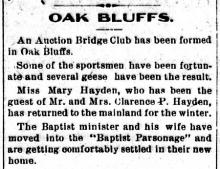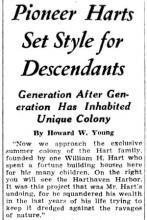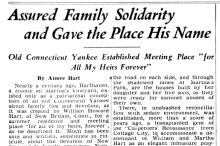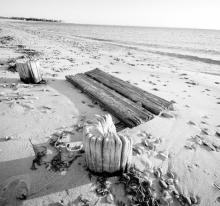Nearly a century ago, Harthaven, a colony on Martha’s Vineyard, existed only as a patriarchal conception of an old Connecticut Yankee about family ties and devotion, as it was created by William Howard Hart, of New Britain, Conn., for a summer residence and meeting place “for all my heirs, forever”, as he described it. Much has been said and written, sometimes in ridicule, about the devotion of New England to family genealogy. Nothing guided William Hart so much, long ago, as unerring instinct toward the treasure of family unity, a dignified pride in the ancestry of affection transposed from one generation to the next, and the staunch guardianship of that heritage.
Enduring for a very long time as an idea, Harthaven is now dignified in the columns of the Vineyard Gazette as a Place, and placidly basks in the glow of the honor. As an idea, it began long before the time of any living soul, and the fine details of its origin, eddying lightly through the stream of accustomed family chatter, have drifted into obscurity, unrecalled for accuracy, as with things long accounted for, but the purpose clear.
Rhythmic Accommodation
As a Place, there were in the beginning 900 acres, spread smoothly just a bit away from the Camp Meeting Ground called Cottage City, and toward the old shire community of Edgartown. Except for changes in the shore line along Nantucket Sound, which has adjusted with rhythmic accommodation to shifting tides, Harthaven is about as it was long ago, when William Hart sketched it all out.
Since the word “airplane” did not exist in his day, his map of its environs, drawn from memory as he paced them out, is remarkably accurate, indicating with obvious satisfaction the tide-water flats of Sengekontacket as clamming vicinities. The comfortable security of the Second Inlet as a bathing spot is noted with reassured paternal concern, where thick sand, the whitest on the Island, is an alabaster tropical luxury, glittering under summer sun.
The land contained within Harthaven rises gently from sunny shores to soft swells, where the brilliant pinnate scarlet oak, wind-espaliered into geometric incongruity with green livers of tamarack, offers adequate scented shade for our brief northern summers. Under this benevolent canopy, the grandsons of William Hart, together with comrades from among the Portuguese lads of the Island, traced with axe and shovel, following more or less carefully the master plan, the graceful sandy roads of Martha’s Park.
In Memory of a Gracious Lady
The park was so called, not for the daughter of Bartholomew Gosnold, as was the Vineyard, but for their own grandmother, Martha Peck Hart, and when mentioned, the title is spoken in the tones of reverent affection becoming the memory of a gracious lady.
Her old summer residence, called The Senior House by members of her family, colonnaded, with its tiny upstairs porch tucked snugly between two wings of the house, facing to the east and the sunrise, still watches the road go by from Oak Bluffs to Edgartown, as it has for a long span of lively years. Along the road on each side, and through the shadowed lanes of Martha’s Park, are the houses built by her daughter and her five sons, as they were ready for summer abodes of their own.
There, in unabashed reconciliation with sedate environment, was established, more than a score of years ago, a transplanted gem of the “Carpenters’ Renaissance” from Cottage City, to accommodate a descendant of William and Martha Hart as an elegant miniature playhouse. And there, too, in sun-dappled shade or pine-spiced cloying mist, two Flying Horses, released from the eternity ring of an old Oak Bluffs carrousel, were lured to the greenwood, to wait always at the gate, rearing themselves in ecstatic welcome.
Nowadays, there are still newer homes built by grandchildren and later descendants, together with residences of friends closely associated with the family through generations of their own. All are happily situated within the realm of communal spirit which is the everlasting charm of Harthaven as an idea and as a place.
Impressive Family Hegira
When the century turned, William and Martha Hart were annually guiding an impressive family hegira from Connecticut homes, so near that last resting place of the earliest ancestral settler in the Tunxis Valley, and the city of Hartford, spreading around the spot where he had forded a river. “And always there was the Vineyard,” wrote Martha Peck Hart in memoriam to her husband and to the younger days of all her family, in a slim, leather-bound volume, stamped in gold with the family name.
Each of her loving words seems luminous with happy recollection, as hurrying years added new named to the family roster, and newer dimensions to the family order; to future generations, she assigned Harthaven as an extension of home, spanning distance, time, and tide, with fervent maternal appreciation.
For upwards of a quarter of a century, the significance of Harthaven has seemed tangible to me, intended as it was by William Howard Hart for his family, toward those who lived at his time, and for those who would come. It has always seemed unique to me in its yearly reassurance of family solidarity. There come new members now and then — often it might be said, from birth, since we are a prolific family — and, frequently, through marriage. Often enough, too, there are memories, some more recent than others, and certain places seem always empty as the years walk backward, coaxing with them, more and more from a shining company.
But always there has been that blessed sense of family continuity, which is just what William Hart had in mind, so long ago now, when he planned it all, trusting that those of us to come would understand how he had wanted it to be; that those who so chose might rendezvous at one place, and each year, for a time, breathe the salt air he loved so well. Evanescent moods and adjustments drift through the spiritual flow of family co-existence and association from one generation to the next, but an old, kindly spirit seems always to abide for everyone at Harthaven, family harbor.










Comments